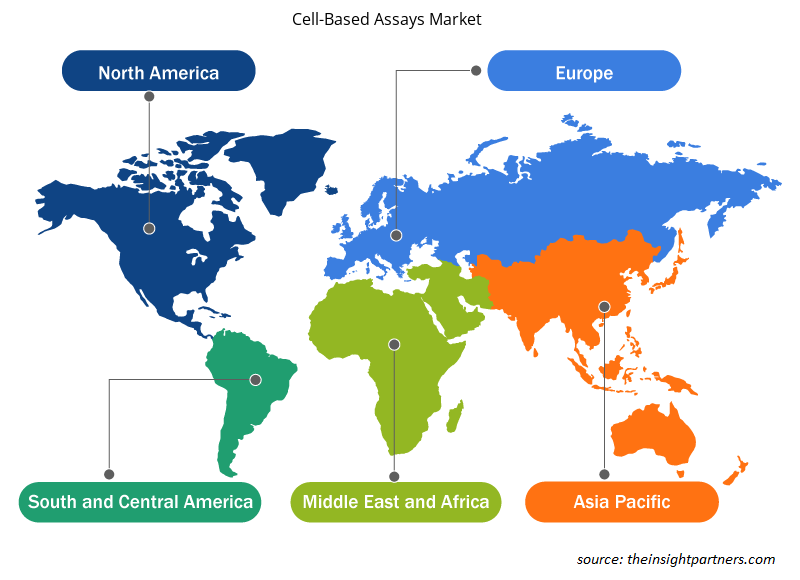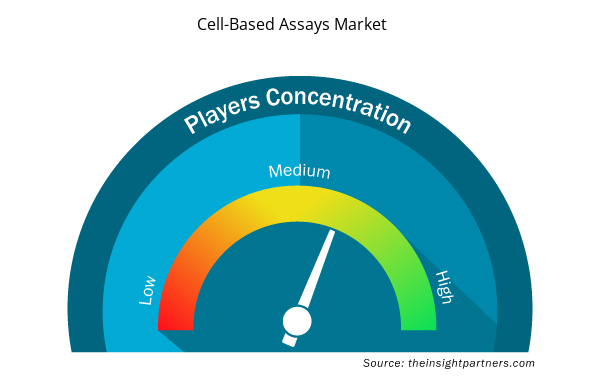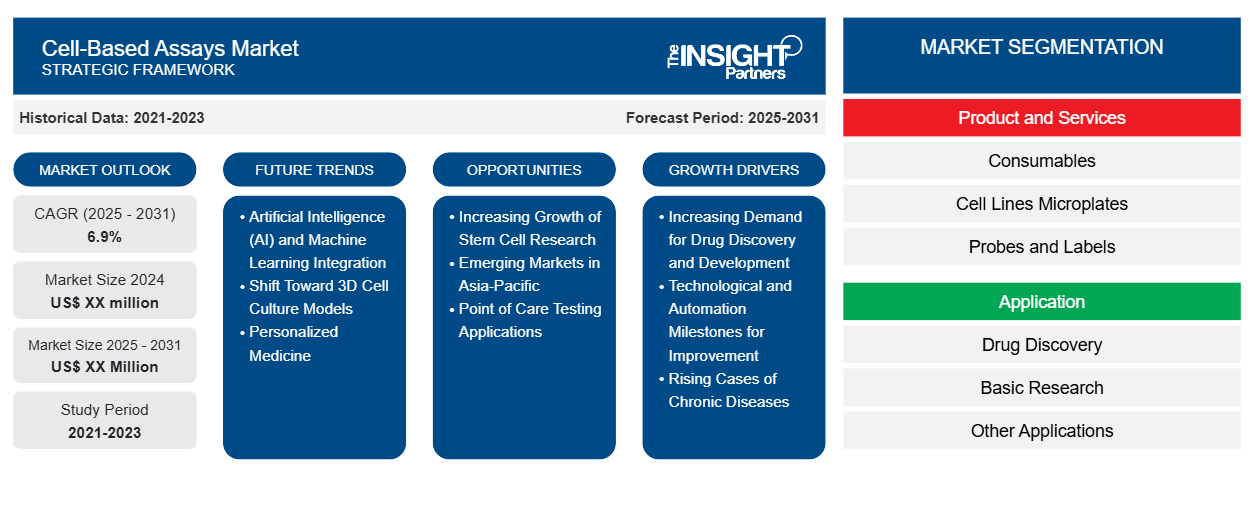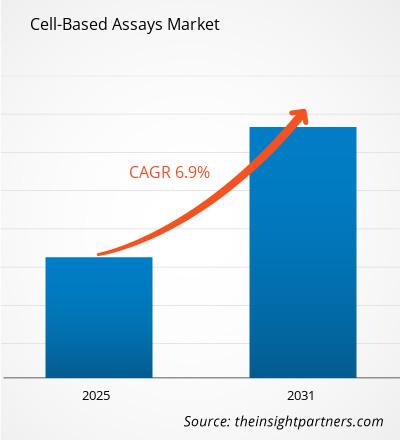Le marché des analyses cellulaires devrait enregistrer un TCAC de 6,9 % de 2024 à 2031, avec une taille de marché passant de XX millions USD en 2024 à XX millions USD d'ici 2031.
Le rapport est segmenté par produit et services (consommables, microplaques de lignées cellulaires, sondes et étiquettes, instruments et logiciels, services et autres). Le rapport est segmenté par application (découverte de médicaments, recherche fondamentale et autres applications). Le rapport présente en outre une analyse basée sur l'utilisation finale (sociétés pharmaceutiques et biopharmaceutiques, CRO et instituts universitaires et de recherche). L'analyse globale est ensuite décomposée au niveau régional et par principaux pays. Le rapport offre la valeur en USD pour l'analyse et les segments ci-dessus.
Objectif du rapport
Le rapport sur le marché des tests cellulaires de The Insight Partners vise à décrire le paysage actuel et la croissance future, les principaux facteurs moteurs, les défis et les opportunités. Cela fournira des informations à diverses parties prenantes commerciales, telles que :
- Fournisseurs/fabricants de technologie : pour comprendre l’évolution de la dynamique du marché et connaître les opportunités de croissance potentielles, leur permettant de prendre des décisions stratégiques éclairées.
- Investisseurs : Effectuer une analyse complète des tendances concernant le taux de croissance du marché, les projections financières du marché et les opportunités qui existent tout au long de la chaîne de valeur.
- Organismes de réglementation : Réglementer les politiques et surveiller les activités du marché dans le but de minimiser les abus, de préserver la confiance des investisseurs et de maintenir l’intégrité et la stabilité du marché.
Segmentation du marché des tests cellulaires
Produits et services
- Consommables
- Microplaques de lignées cellulaires
- Sondes et étiquettes
- Instruments et logiciels
- Services
- Autres
Application
- Découverte de médicaments
- Recherche fondamentale
- Autres applications
Utilisation finale
- Sociétés pharmaceutiques et biopharmaceutiques
- Responsables du développement économique
- Instituts universitaires et de recherche
Géographie
- Amérique du Nord
- Europe
- Asie-Pacifique
- Amérique du Sud et Amérique centrale
- Moyen-Orient et Afrique
Personnalisez ce rapport en fonction de vos besoins
Vous bénéficierez d'une personnalisation gratuite de n'importe quel rapport, y compris de certaines parties de ce rapport, d'une analyse au niveau des pays, d'un pack de données Excel, ainsi que d'offres et de remises exceptionnelles pour les start-ups et les universités.
- Obtenez les principales tendances clés du marché de ce rapport.Cet échantillon GRATUIT comprendra une analyse de données, allant des tendances du marché aux estimations et prévisions.
Facteurs de croissance du marché des tests cellulaires
- Demande croissante en matière de découverte et de développement de médicaments : il s’agit d’un processus très long, coûteux et risqué, qui présente d’énormes taux d’échec lors des essais cliniques. Il a permis de cribler des milliers de composés de manière rentable et à haut rendement. Les candidats en phase précoce ont également permis de tester biologiquement les composés pour déterminer leur activité, leur toxicité et leur efficacité. Cela signifie que l’industrie pharmaceutique a augmenté ses exigences concernant l’utilisation de ces tests, car elle souhaite que tout soit plus rapide et plus fiable en termes de pipelines de développement de médicaments.
- Étapes technologiques et d'automatisation pour l'amélioration : Grâce aux avancées technologiques, le marché des tests cellulaires a connu une croissance significative. L'automatisation, la miniaturisation, ainsi que les innovations dans les techniques d'imagerie et d'analyse ont amélioré la sensibilité, la reproductibilité et le rendement des tests cellulaires. De nouvelles techniques de criblage à haut contenu (HCS) et de microscopie optique très avancées ont permis aux scientifiques d'étudier les réponses cellulaires de manière beaucoup plus efficace et précise, et cette sophistication drastique est généralement requise lors des processus de découverte de médicaments et d'essais de toxicité.
- Augmentation des cas de maladies chroniques : Aujourd’hui, avec l’augmentation du nombre de maladies chroniques dans le monde – des tumeurs malignes aux maladies cardiovasculaires en passant par les troubles liés au sucre –, la nécessité de proposer de meilleures options de traitement s’est indéniablement accrue. Les tests cellulaires ont diverses applications dans la compréhension des mécanismes des maladies, l’identification des biomarqueurs et le développement de thérapies personnalisées. Et plus les maladies chroniques pèsent sur les systèmes de santé, plus on peut s’attendre à une augmentation de la demande de technologies de tests cellulaires.
Tendances futures du marché des tests cellulaires
- Intégration de l'intelligence artificielle (IA) et de l'apprentissage automatique : ces deux technologies sont intégrées aux plateformes d'analyse cellulaire afin d'améliorer l'interprétation des données et de les analyser encore plus. L'IA et l'apprentissage automatique peuvent aider à gérer les vastes piles de données générées par l'imagerie avancée et les techniques de criblage à haut débit. Les algorithmes d'IA aident à identifier des modèles très complexes et à prédire l'efficacité ou la toxicité des médicaments et, ce faisant, à réduire considérablement le temps nécessaire pour trouver des candidats médicaments. À mesure que l'IA progresse, elle jouera invariablement un rôle encore plus important dans l'optimisation des flux de travail d'analyse en termes de précision.
- Passage aux modèles de culture cellulaire 3D : les cultures cellulaires bidimensionnelles sont de moins en moins utilisées comme modèle d'analyse, malgré leur longue histoire. L'environnement authentique des cellules est reproduit de près par les cultures tridimensionnelles, qui représentent la biologie humaine avec plus de précision, produisent des tests plus fiables et fournissent de meilleures prévisions de la réponse aux médicaments. Ces modèles créent un environnement propice à l'architecture tissulaire avancée, à l'interaction cellulaire et au développement de maladies, ce qui est particulièrement important pour la recherche sur le cancer et le dépistage de médicaments.
- Médecine personnalisée : Lorsque la médecine personnalisée deviendra le thème central des soins de santé, des tests cellulaires seront utilisés pour développer des thérapies individualisées. L'analyse des réponses génétiques et cellulaires uniques d'un patient peut conduire à des thérapies individualisées, mais en quelque sorte plus efficaces. Les nouvelles tendances en matière de criblage personnalisé de médicaments impliquent des cellules dérivées de patients pour une découverte de médicaments plus ciblée et, à terme, l'identification des meilleures options thérapeutiques pour chaque patient.
Opportunités de marché pour les tests cellulaires
- Croissance croissante de la recherche sur les cellules souches : la recherche sur les cellules souches est prometteuse pour la médecine régénératrice, le développement de médicaments et la modélisation des maladies en tant qu'applications émergentes. Les tests basés sur les cellules aident à déterminer le comportement des cellules souches, à différencier les cellules souches et à comprendre les effets de divers composés sur la fonction des cellules souches. La recherche sur les cellules souches continue de progresser, ce qui entraîne une demande accrue de tests permettant d'évaluer la puissance, la sécurité et les voies de différenciation des cellules souches.
- Marchés émergents en Asie-Pacifique : La région Asie-Pacifique est en passe de devenir une zone de forte croissance pour les sciences de la vie et la biotechnologie. La Chine, l'Inde et le Japon investissent massivement dans les infrastructures de santé, la découverte de médicaments et la recherche. La demande pour ces tests va donc augmenter fortement dans ces marchés émergents. Le nombre croissant d'entreprises pharmaceutiques et biotechnologiques dans la région, associé à des politiques gouvernementales favorables, offre des opportunités lucratives aux acteurs du marché.
- Applications de tests au point d'intervention : les tests cellulaires vont potentiellement remodeler la manière dont les tests au point d'intervention sont effectués, en fournissant un diagnostic rapide et précis. Ces tests peuvent être effectués au point d'intervention pour la détection de maladies, la mesure de la réponse immunitaire ou le dépistage de la résistance aux médicaments, évitant ainsi le laboratoire centralisé. Compte tenu des marchés émergents, de plus en plus de personnes demandent des solutions de diagnostic rapides et fiables ; il y a donc plus de place pour développer des technologies de tests cellulaires portables.
Aperçu régional du marché des tests cellulaires
Les tendances régionales et les facteurs influençant le marché des tests cellulaires tout au long de la période de prévision ont été expliqués en détail par les analystes d’Insight Partners. Cette section traite également des segments et de la géographie du marché des tests cellulaires en Amérique du Nord, en Europe, en Asie-Pacifique, au Moyen-Orient et en Afrique, ainsi qu’en Amérique du Sud et en Amérique centrale.

- Obtenez les données régionales spécifiques au marché des tests cellulaires
Portée du rapport sur le marché des tests cellulaires
| Attribut de rapport | Détails |
|---|---|
| Taille du marché en 2024 | XX millions de dollars américains |
| Taille du marché d'ici 2031 | XX millions de dollars américains |
| Taux de croissance annuel composé mondial (2024-2031) | 6,9% |
| Données historiques | 2021-2023 |
| Période de prévision | 2025-2031 |
| Segments couverts | Par produits et services
|
| Régions et pays couverts | Amérique du Nord
|
| Leaders du marché et profils d'entreprises clés |
|
Densité des acteurs du marché des tests cellulaires : comprendre son impact sur la dynamique commerciale
Le marché des tests cellulaires connaît une croissance rapide, tirée par la demande croissante des utilisateurs finaux en raison de facteurs tels que l'évolution des préférences des consommateurs, les avancées technologiques et une plus grande sensibilisation aux avantages du produit. À mesure que la demande augmente, les entreprises élargissent leurs offres, innovent pour répondre aux besoins des consommateurs et capitalisent sur les tendances émergentes, ce qui alimente davantage la croissance du marché.
La densité des acteurs du marché fait référence à la répartition des entreprises ou des sociétés opérant sur un marché ou un secteur particulier. Elle indique le nombre de concurrents (acteurs du marché) présents sur un marché donné par rapport à sa taille ou à sa valeur marchande totale.
Les principales entreprises opérant sur le marché des tests cellulaires sont :
- Société Danaher
- Thermo Fisher Scientific
- Merck KGaA
- Becton, Dickinson et compagnie
- PerkinElmer, Inc.
Avis de non-responsabilité : les sociétés répertoriées ci-dessus ne sont pas classées dans un ordre particulier.

- Obtenez un aperçu des principaux acteurs du marché des tests cellulaires
Principaux arguments de vente
- Couverture complète : Le rapport couvre de manière exhaustive l’analyse des produits, des services, des types et des utilisateurs finaux du marché des tests cellulaires, offrant un paysage holistique.
- Analyse d’experts : Le rapport est compilé sur la base d’une compréhension approfondie des experts et analystes du secteur.
- Informations à jour : Le rapport garantit la pertinence commerciale en raison de sa couverture des informations récentes et des tendances des données.
- Options de personnalisation : ce rapport peut être personnalisé pour répondre aux exigences spécifiques du client et s'adapter parfaitement aux stratégies commerciales.
Le rapport de recherche sur le marché des tests cellulaires peut donc aider à ouvrir la voie au décodage et à la compréhension du scénario de l’industrie et des perspectives de croissance. Bien qu’il puisse y avoir quelques préoccupations valables, les avantages globaux de ce rapport ont tendance à l’emporter sur les inconvénients.
- Analyse historique (2 ans), année de base, prévision (7 ans) avec TCAC
- Analyse PEST et SWO
- Taille du marché Valeur / Volume - Mondial, Régional, Pays
- Industrie et paysage concurrentiel
- Ensemble de données Excel



Report Coverage
Revenue forecast, Company Analysis, Industry landscape, Growth factors, and Trends

Segment Covered
This text is related
to segments covered.

Regional Scope
North America, Europe, Asia Pacific, Middle East & Africa, South & Central America

Country Scope
This text is related
to country scope.
Questions fréquemment posées
Drug Discovery segment, by application, dominated the market in 2023.
Players operating in the market are Danaher Corporation, Thermo Fisher Scientific, Merck KGaA, Becton, Dickinson and Company, PerkinElmer, Inc., Promega Corporation, Charles River Laboratories, Lonza, BioAgilytix Labs, Reaction Biology Corporation
North America region dominated the Cell-Based Assay market in 2023.
Increasing Growth of Stem Cell Research act as a opportunity for growth of the market in forecast period.
The Cell-Based Assay Market is estimated to witness a CAGR of 6.9% from 202#to 2031
The major factors driving the Cell-Based Assay market are:
1. Increasing Demand for Drug Discovery and Development
2. Technological and Automation Milestones for Improvement
Trends and growth analysis reports related to Life Sciences : READ MORE..
1. Danaher Corporation
2. Thermo Fisher Scientific
3. Merck KGaA
4. Becton, Dickinson and Company
5. PerkinElmer, Inc.
6. Promega Corporation
7. Charles River Laboratories
8. Lonza
9. BioAgilytix Labs
10. Reaction Biology Corporation
The Insight Partners performs research in 4 major stages: Data Collection & Secondary Research, Primary Research, Data Analysis and Data Triangulation & Final Review.
- Data Collection and Secondary Research:
As a market research and consulting firm operating from a decade, we have published and advised several client across the globe. First step for any study will start with an assessment of currently available data and insights from existing reports. Further, historical and current market information is collected from Investor Presentations, Annual Reports, SEC Filings, etc., and other information related to company’s performance and market positioning are gathered from Paid Databases (Factiva, Hoovers, and Reuters) and various other publications available in public domain.
Several associations trade associates, technical forums, institutes, societies and organization are accessed to gain technical as well as market related insights through their publications such as research papers, blogs and press releases related to the studies are referred to get cues about the market. Further, white papers, journals, magazines, and other news articles published in last 3 years are scrutinized and analyzed to understand the current market trends.
- Primary Research:
The primarily interview analysis comprise of data obtained from industry participants interview and answers to survey questions gathered by in-house primary team.
For primary research, interviews are conducted with industry experts/CEOs/Marketing Managers/VPs/Subject Matter Experts from both demand and supply side to get a 360-degree view of the market. The primary team conducts several interviews based on the complexity of the markets to understand the various market trends and dynamics which makes research more credible and precise.
A typical research interview fulfils the following functions:
- Provides first-hand information on the market size, market trends, growth trends, competitive landscape, and outlook
- Validates and strengthens in-house secondary research findings
- Develops the analysis team’s expertise and market understanding
Primary research involves email interactions and telephone interviews for each market, category, segment, and sub-segment across geographies. The participants who typically take part in such a process include, but are not limited to:
- Industry participants: VPs, business development managers, market intelligence managers and national sales managers
- Outside experts: Valuation experts, research analysts and key opinion leaders specializing in the electronics and semiconductor industry.
Below is the breakup of our primary respondents by company, designation, and region:

Once we receive the confirmation from primary research sources or primary respondents, we finalize the base year market estimation and forecast the data as per the macroeconomic and microeconomic factors assessed during data collection.
- Data Analysis:
Once data is validated through both secondary as well as primary respondents, we finalize the market estimations by hypothesis formulation and factor analysis at regional and country level.
- Macro-Economic Factor Analysis:
We analyse macroeconomic indicators such the gross domestic product (GDP), increase in the demand for goods and services across industries, technological advancement, regional economic growth, governmental policies, the influence of COVID-19, PEST analysis, and other aspects. This analysis aids in setting benchmarks for various nations/regions and approximating market splits. Additionally, the general trend of the aforementioned components aid in determining the market's development possibilities.
- Country Level Data:
Various factors that are especially aligned to the country are taken into account to determine the market size for a certain area and country, including the presence of vendors, such as headquarters and offices, the country's GDP, demand patterns, and industry growth. To comprehend the market dynamics for the nation, a number of growth variables, inhibitors, application areas, and current market trends are researched. The aforementioned elements aid in determining the country's overall market's growth potential.
- Company Profile:
The “Table of Contents” is formulated by listing and analyzing more than 25 - 30 companies operating in the market ecosystem across geographies. However, we profile only 10 companies as a standard practice in our syndicate reports. These 10 companies comprise leading, emerging, and regional players. Nonetheless, our analysis is not restricted to the 10 listed companies, we also analyze other companies present in the market to develop a holistic view and understand the prevailing trends. The “Company Profiles” section in the report covers key facts, business description, products & services, financial information, SWOT analysis, and key developments. The financial information presented is extracted from the annual reports and official documents of the publicly listed companies. Upon collecting the information for the sections of respective companies, we verify them via various primary sources and then compile the data in respective company profiles. The company level information helps us in deriving the base number as well as in forecasting the market size.
- Developing Base Number:
Aggregation of sales statistics (2020-2022) and macro-economic factor, and other secondary and primary research insights are utilized to arrive at base number and related market shares for 2022. The data gaps are identified in this step and relevant market data is analyzed, collected from paid primary interviews or databases. On finalizing the base year market size, forecasts are developed on the basis of macro-economic, industry and market growth factors and company level analysis.
- Data Triangulation and Final Review:
The market findings and base year market size calculations are validated from supply as well as demand side. Demand side validations are based on macro-economic factor analysis and benchmarks for respective regions and countries. In case of supply side validations, revenues of major companies are estimated (in case not available) based on industry benchmark, approximate number of employees, product portfolio, and primary interviews revenues are gathered. Further revenue from target product/service segment is assessed to avoid overshooting of market statistics. In case of heavy deviations between supply and demand side values, all thes steps are repeated to achieve synchronization.
We follow an iterative model, wherein we share our research findings with Subject Matter Experts (SME’s) and Key Opinion Leaders (KOLs) until consensus view of the market is not formulated – this model negates any drastic deviation in the opinions of experts. Only validated and universally acceptable research findings are quoted in our reports.
We have important check points that we use to validate our research findings – which we call – data triangulation, where we validate the information, we generate from secondary sources with primary interviews and then we re-validate with our internal data bases and Subject matter experts. This comprehensive model enables us to deliver high quality, reliable data in shortest possible time.


 Obtenez un échantillon gratuit pour ce rapport
Obtenez un échantillon gratuit pour ce rapport